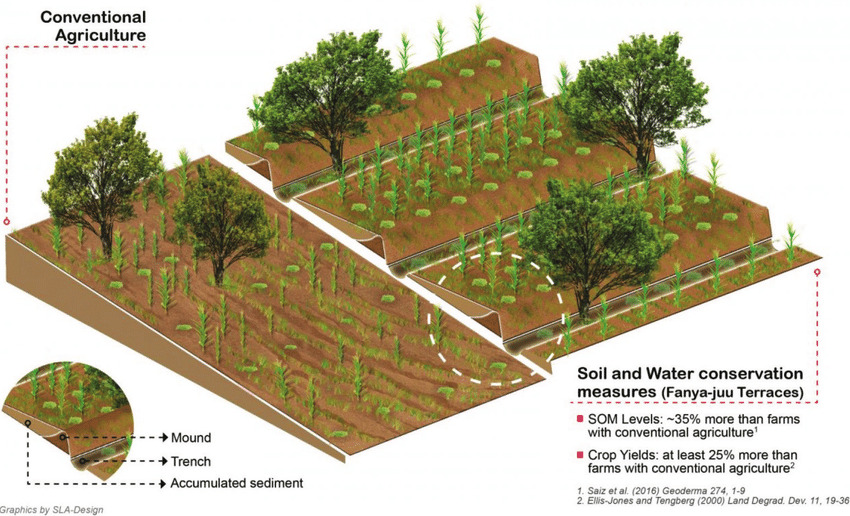
Over 50,000 smallholder farmers in Eastern and Central Kenya are recording a more than doubling of yields and reduced soil erosion after embracing a soil conservation scheme that involves digging trenches in hillsides to trap runaway water and soil.
The scheme christened Fanya Juu which is practiced in areas with low or high rainfall involves digging trenches along the contour of a hillside. The soil that is dug from the trenches is thrown on the upper side of the trench and eventually forms a ridge. This soil ends up forming a ridge and even leveling off the terrace.
Farmers then use the bunds to plant various crops like fodder while in the terraces water is trapped which is used in the production of the main crops.
In Ndithini area of Machakos County an area with limited rainfall, farmers are always left frustrated whenever it rains. With no means to harvest rainfall when it rains the rains permeate through the farms, carrying with them the nutritious topsoil. The effect is a dip in yields after harvest.
But the situation has been reversed with the Fanya Juu terraces. Having formed themselves in groups, the farmers move from one farm to the other, digging the trenches a venture they have been involved in for the last five years. Mutalia Farmers group which has a membership of 500 farmers is perhaps the success story of Fanya Juu terrace in Machakos.
Related News: Conservation agriculture halves ploughing costs while preserving soils
Related News: Farm loan pegs interest on soil conservation
In the three years, it has been in existence, all its members’ farms have terraces that have inspired a new generation of farmers. “I used to grow a lot of sorghum and cassava because that is what could do well in the tough climatic conditions. But I currently grow even vegetables, tomatoes, and spinach. I also have entered into livestock rearing because at the ridges I was advised to grow something like bananas or Napier to firm up the soil. It feels good to not only rely on the rains,” said Eutychus Kilonzo, one of the pioneer farmers of the Fanya Juu terraces.

The story reverberates in the hilly farms in the Saba Saba area of Murang’a County. A report by the Ministry of Agriculture indicated that up to 70 per cent of the topsoil had been washed away due to continuous rains. And with the washing of the soil nutrients were swept off. The concomitant effect was a dip in yield as recorded in the subsequent two seasons where yield dipped by a staggering 60 per cent. Until soil conservation officers from the Ministry of Agriculture organized the farmers into groups and got them to dig trenches.
Related News: Conservation agriculture, intercropping breathes new life to Western soils
“It was mission-critical in Saba Saba. The soils were so loose after incessant `erosions. The farmers had spent a fortune trying to rescue the situation by buying fertilizers. But once the topsoil is washed away nothing much can be done. Fertilizers can never be the solution. So we trained them on Fanya Juu terraces. Within the second harvest farmers had not only gone back to their usual yields but managed to double them,” said Samson Kibara a soil conservation official from the Ministry of Agriculture.
And as the farmers now worry less about erosion and concentrate on food production, soil experts argue that with the unprecedented changes in weather patterns, farmers should brace themselves for more torrential rains, which will carry away soils, and dry spells, which will affect crop’s moisture availability. “The ultimate and most cost-effective solution is the terraces, for the sake of the soils and water,” said Kibara.
Grass is planted on top of the bund to stabilise it. "Bane grass" is one of the best varieties for Kenya. Bananas or other trees may be planted in the trench.
















Comments powered by CComment